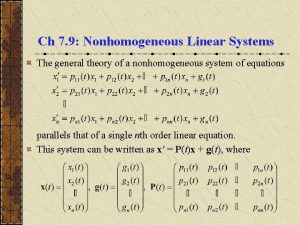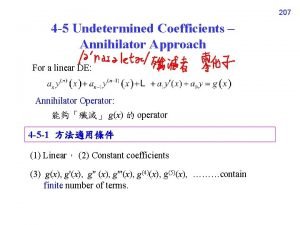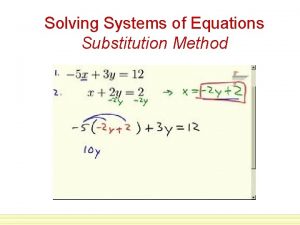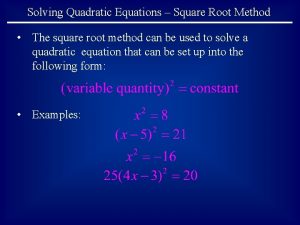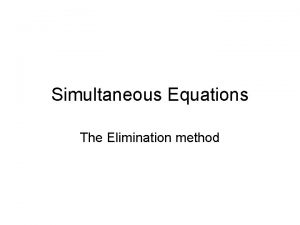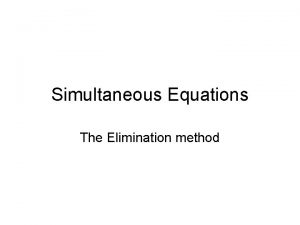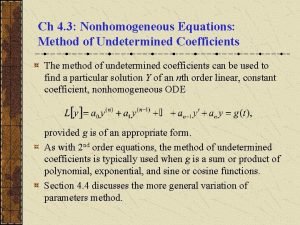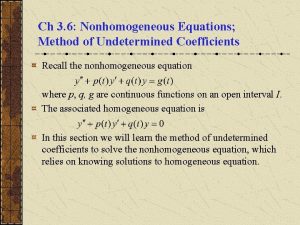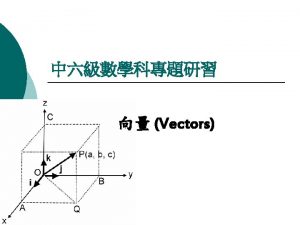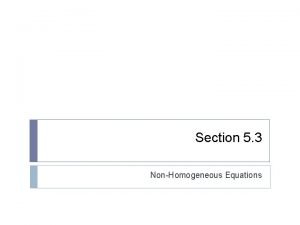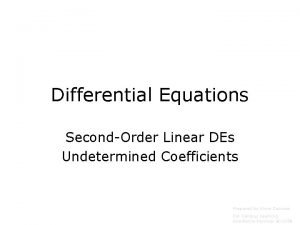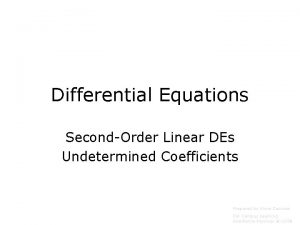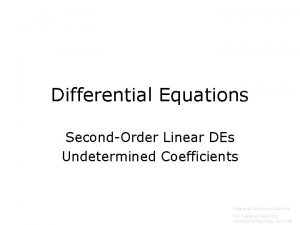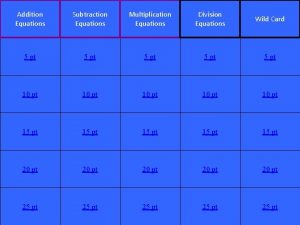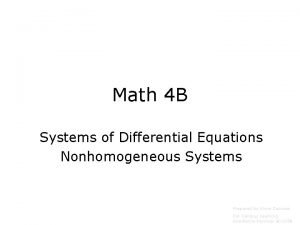Ch 3 5 Nonhomogeneous Equations Method of Undetermined














- Slides: 14

Ch 3. 5: Nonhomogeneous Equations; Method of Undetermined Coefficients Recall the nonhomogeneous equation where p, q, g are continuous functions on an open interval I. The associated homogeneous equation is In this section we will learn the method of undetermined coefficients to solve the nonhomogeneous equation, which relies on knowing solutions to homogeneous equation.

Theorem 3. 6. 1 If Y 1, Y 2 are solutions of nonhomogeneous equation then Y 1 - Y 2 is a solution of the homogeneous equation If y 1, y 2 form a fundamental solution set of homogeneous equation, then there exists constants c 1, c 2 such that

Theorem 3. 6. 2 (General Solution) The general solution of nonhomogeneous equation can be written in the form where y 1, y 2 form a fundamental solution set of homogeneous equation, c 1, c 2 are arbitrary constants and Y is a specific solution to the nonhomogeneous equation.

Method of Undetermined Coefficients Recall the nonhomogeneous equation with general solution In this section we use the method of undetermined coefficients to find a particular solution Y to the nonhomogeneous equation, assuming we can find solutions y 1, y 2 for the homogeneous case. The method of undetermined coefficients is usually limited to when p and q are constant, and g(t) is a polynomial, exponential, sine or cosine function.

Example 1: Exponential g(t) Consider the nonhomogeneous equation We seek Y satisfying this equation. Since exponentials replicate through differentiation, a good start for Y is: Substituting these derivatives into differential equation, Thus a particular solution to the nonhomogeneous ODE is

Example 2: Sine g(t), First Attempt (1 of 2) Consider the nonhomogeneous equation We seek Y satisfying this equation. Since sines replicate through differentiation, a good start for Y is: Substituting these derivatives into differential equation, Since sin(x) and cos(x) are linearly independent (they are not multiples of each other), we must have c 1= c 2 = 0, and hence 2 + 5 A = 3 A = 0, which is impossible.

Example 2: Sine g(t), Particular Solution (2 of 2) Our next attempt at finding a Y is Substituting these derivatives into ODE, we obtain Thus a particular solution to the nonhomogeneous ODE is

Example 3: Polynomial g(t) Consider the nonhomogeneous equation We seek Y satisfying this equation. We begin with Substituting these derivatives into differential equation, Thus a particular solution to the nonhomogeneous ODE is

Example 4: Product g(t) Consider the nonhomogeneous equation We seek Y satisfying this equation, as follows: Substituting derivatives into ODE and solving for A and B:

Discussion: Sum g(t) Consider again our general nonhomogeneous equation Suppose that g(t) is sum of functions: If Y 1, Y 2 are solutions of respectively, then Y 1 + Y 2 is a solution of the nonhomogeneous equation above.

Example 5: Sum g(t) Consider the equation Our equations to solve individually are Our particular solution is then

Example 6: First Attempt (1 of 3) Consider the equation We seek Y satisfying this equation. We begin with Substituting these derivatives into ODE: Thus no particular solution exists of the form

Example 6: Homogeneous Solution (2 of 3) Thus no particular solution exists of the form To help understand why, recall that we found the corresponding homogeneous solution in Section 3. 4 notes: Thus our assumed particular solution solves homogeneous equation instead of the nonhomogeneous equation.

Example 6: Particular Solution Our next attempt at finding a Y is: Substituting derivatives into ODE, (3 of 3)
 Nonhomogeneous differential equation
Nonhomogeneous differential equation Lagranges equations of undetermined multiplier
Lagranges equations of undetermined multiplier Nonhomogeneous linear system
Nonhomogeneous linear system Undetermined coefficients
Undetermined coefficients Numbers in tagalog
Numbers in tagalog Monoclonal gammopathy of undetermined significance
Monoclonal gammopathy of undetermined significance Conclusion of symposium
Conclusion of symposium 9-3 practice polar and rectangular forms of equations
9-3 practice polar and rectangular forms of equations Translate word equations to chemical equations
Translate word equations to chemical equations System of equations substitution method
System of equations substitution method Square root method quadratic equations
Square root method quadratic equations Factored equation
Factored equation Simultaneous elimination method
Simultaneous elimination method Simultaneous equations elimination method
Simultaneous equations elimination method Persamaan linier simultan adalah
Persamaan linier simultan adalah


